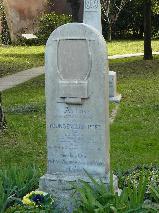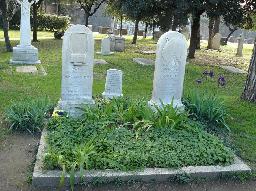Keats, John |
| POET (ENGLAND) |
|
BORN 31 Oct 1795, London: 85 Moorgate - DIED 23 Feb 1821, Roma, Lazio: Piazza di Spagna 26 (now the Keats-Shelley Memorial House) CAUSE OF DEATH tuberculosis GRAVE LOCATION Roma, Lazio: Cimitero Acattolico, Via Caio Cestio 6 (Parte Antica, Plot 51 (gravestone 31)) |
|
Son of Thomas Keats, who worked as a barman at the Hoop and Swan Pub (now the Keats and the Globe near Moorgate station). He was educated at the Clark school in Enfield, where headmaster John Clarke introduced him to a lot of literature. In 1804 his father died and his mother lived with the children in Edmonton with her mother. She died in 1810 and in that same year Keats left school and became an apprentice to the apothecary and surgeon Thomas Hammond. In 1814 he wrote his poem "An Imitation of Spenser" and in 1815 he became a medical student at Guy's Hospital. By the time he became a licensed apothecary in 1816 he had already decided that he wanted to be a poet. During that year Leigh Hunt published his poem "O Solitude" in The Examiner. In 1817 "Poems" was published. Hunt introduced him to several literary figures, amon them Charles Lamb and John Hamilton Reynolds. His poem "Endymion" was slashed by the critics. In 1818 he went on a walking journey with Charles Armitage Brown, but during the tour he caught a bad cold. When he was back he nursed his brother Tom who suffered from tuberculosis (Tom died on 1 Dec 1818). Somewhere in 1818 he met eighteen year Fanny Brawne. He also saw a women named Isabella Jones. In 1819 at Wentworth Place in London (now Keats House) he wrote "The Eve of St. Agnes", "La Belle Dame Sans Merci" and "Hyperion", soon followed by "To Autumn". They were published in a volume that appeared in 1820 and was treated better by the critics than his previous volumes. In 1819 Fanny and her mother had moved to another part of the house where Keats lived and they saw each other often now and he and Fanny became engaged. In 1820 he was diagnosed with tuberculosis and he had two two lung haemorrhages. His engagement with Fanny was broken and on advise of his doctors he left for Italy with his close friend Joseph Severn. They went to Rome, where he lived in a villa next to the Spanish Steps (now the Keats-Shelley Memorial House). For a short while he felt better, but soon his illness grew worse. He died on 23 Feb 1821 and he was buried in the Protestant Cemetery in Rome. Joseph Severn was buried next to Keats after his death in 1879. Leigh Hunt believed that the critics had killed Keats and Shelley remembered him in his poem "Adonais". Lord Byron, who claimed he didn't like Keats' poetry, wrote in a letter to his publisher John Murray: "Who killed John Keats? / I, says the Quarterly / So savage & Tartarly / 'Twas one of my feats". Related persons • was a friend of Haydon, Benjamin • was a friend of Severn, Joseph • was painted by Severn, Joseph • knew Shelley, Percy Bysshe • influenced Wilde, Oscar |
Sources • John Keats - Wikipedia (EN) • Lord Byron & John Keats Rivalry & Hatred Summary • John-Keats.com |







